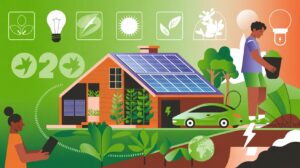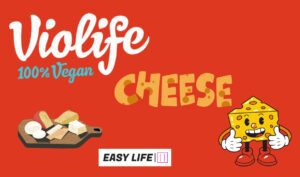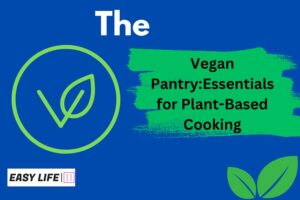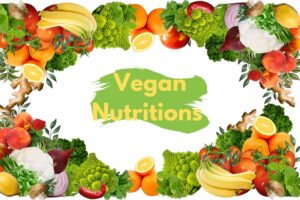Welcome to our comprehensive guide on “Vegan Meal Prep: Tips for a Busy Week.” The beauty of meal prepping lies in its simplicity and efficiency, but for those following a plant-based diet, it might come with its unique set of challenges. From ensuring balanced nutrition to keeping meals exciting and tasty, vegan meal prepping can seem daunting to both beginners and seasoned vegans alike.
This blog post aims to break down those barriers and demystify the process of vegan meal prep. Whether you’re a full-time professional, a busy parent, or a student juggling multiple responsibilities, this guide is designed to help you navigate your vegan journey with ease and confidence.
Through this blog, we will explore the benefits of vegan meal prep, discuss essential ingredients you should always have in your pantry, and share a variety of delicious, easy-to-make recipes. Moreover, we’ll delve into effective meal-prepping techniques, provide a step-by-step meal-prep plan for a week, and offer solutions to common challenges you might encounter along the way.
Join us as we guide you through the process of simplifying your vegan meal prep, saving you time, reducing stress, and most importantly, ensuring that you’re nourishing your body with wholesome, plant-based meals all week long. Let’s begin our journey towards efficient, nutritious, and exciting vegan meal prepping!
Table of Contents
Toggle1. Understanding Vegan Meal Prep
Vegan meal prep is a strategy that involves planning, preparing, and packaging your meals or meal components ahead of time. This process ensures that you have ready-to-eat, plant-based meals available throughout the week, saving time on daily cooking and decision-making.
A. Defining Vegan Meal Prep
Vegan meal prep is no different from standard meal prepping, with the exception that it excludes all animal products. This means no meat, dairy, eggs, or other animal-derived ingredients. Instead, meals are created using a colourful variety of fruits, vegetables, grains, legumes, nuts, seeds, and plant-based proteins.
B. Benefits of Vegan Meal Prep
- Health Benefits: Vegan meal prep allows you to control the ingredients that go into your meals, making it easier to maintain a nutrient-rich diet. Preparing meals ahead of time can help you avoid last-minute unhealthy food choices, aiding in weight management and overall health.
- Time-saving Benefits: One of the most significant advantages of meal prep is the time it saves. By dedicating a few hours one day a week to preparing your meals, you free up a substantial amount of time during the week that would otherwise be spent cooking.
- Environmental Benefits: A plant-based diet is known to have a lower environmental impact than a diet high in animal products. By prepping vegan meals, you’re not only nourishing your body but also contributing to the health of our planet.
In the next sections, we’ll delve deeper into the essential ingredients for vegan meal prep and explore some delicious and nutritious recipes for breakfast, lunch, dinner, and snacks. We’ll also discuss some effective meal-prepping techniques and provide a step-by-step guide to creating your own vegan meal-prep plan.
2. Essential Ingredients for Vegan Meal Prep
A well-stocked pantry is key to successful vegan meal prep. Having a variety of ingredients on hand will ensure that you can whip up nutritious meals even on the busiest of days. Let’s look at the essential components for your vegan meal prep.
A. Overview of Essential Pantry Staples
- Whole Grains: These are a great source of fibre and keep you feeling full for longer. Stock up on brown rice, quinoa, oats, whole wheat pasta, and other whole grains.
- Legumes: Beans, lentils, chickpeas, and peas are excellent sources of plant-based protein. They can be used in a variety of dishes from salads to stews.
- Nuts and Seeds: Almonds, walnuts, flaxseeds, chia seeds, and more are nutrient-dense foods that add a delightful crunch and a boost of healthy fats to your meals.
- Fruits and Vegetables: Keep a variety of fresh, frozen, and canned fruits and vegetables. They add colour, flavour, and most importantly, essential vitamins and minerals to your diet.
- Plant-based Proteins: Tofu, tempeh, and seitan are versatile plant-based proteins that can be used in various dishes. Additionally, consider plant-based kinds of milk and cheeses for dairy alternatives.
- Herbs and Spices: These are essential for adding flavour to your meals without adding extra calories or sodium. They also offer various health benefits.
B. Importance of Variety in a Vegan Diet
It’s important to remember that variety is key in a vegan diet. Eating a diverse range of foods not only keeps your meals interesting but also helps to ensure you get a wide spectrum of nutrients. Try to incorporate different colours and types of fruits, vegetables, grains, and proteins into your meals.
C. Sourcing and Selecting High-Quality Vegan Ingredients
When it comes to sourcing your ingredients, consider your local farmer’s markets, food co-ops, and health food stores. These places often offer a variety of fresh, organic, and locally sourced produce. When selecting ingredients, look for those that are in season, as they tend to be fresher and more flavorful.
With a well-stocked pantry, meal prep becomes much easier and more enjoyable. Up next, we’ll share some easy and delicious vegan meal prep recipes to help you get started.
3. Recipe Ideas for Vegan Meal Prep
A well-planned vegan meal prep should include a variety of meals to keep your diet balanced and enjoyable. Let’s dive into some simple and delectable vegan meal prep recipes for breakfast, lunch, dinner, and snacks.
A. Breakfast Recipe Ideas
- Overnight oats: A no-cook method of making oatmeal. Mix oats with plant-based milk and your choice of fruits, nuts, seeds, or sweeteners, then let it sit overnight in the refrigerator.
- Smoothie packs: Pre-portion fruits, vegetables, and protein powder into freezer bags. When you’re ready for a smoothie, just grab a pack, blend it with your choice of liquid, and go.
- Vegan breakfast burritos: Scramble tofu with vegetables and spices, then wrap in a tortilla. These can be made in advance and frozen for later use.
B. Lunch Recipe Ideas
- Quinoa salad: Toss cooked quinoa with a variety of colourful vegetables, beans, and a tangy dressing. This can be portioned out into containers for an easy grab-and-go lunch.
- Chickpea ‘tuna’ sandwiches: Mash chickpeas with vegan mayo, celery, and spices for a vegan take on tuna salad. Make a big batch and use it throughout the week for sandwiches, wraps, or salads.
- Vegan sushi bowls: Layer-cooked sushi rice, pickled vegetables, avocado, and baked tofu in a bowl for a deconstructed sushi roll.
C. Dinner Recipe Ideas
- Lentil curry: Cook lentils with tomatoes, coconut milk, and a mix of spices for a warming and protein-packed curry. Serve with rice or naan.
- Stuffed bell peppers: Fill bell peppers with a mixture of cooked quinoa, black beans, corn, and salsa, then bake until tender. These can be made ahead and reheated when ready to eat.
- Vegan lasagna: Layer lasagna noodles with vegan ricotta, marinara sauce, and roasted vegetables for a comforting dinner. Make a big pan and portion out for multiple meals.
D. Snacks and Dessert Recipe Ideas
- Hummus and veggies: Blend chickpeas with tahini, lemon juice, garlic, and olive oil for a healthy and filling snack. Portion out into containers with a variety of cut-up vegetables.
- Energy balls: Process dates, nuts, oats, and your choice of add-ins (like coconut, chocolate chips, or dried fruit) in a food processor, then roll into balls. These are great on-the-go snacks and can be stored in the fridge for a week.
- Chia pudding: Mix chia seeds with plant-based milk and sweetener, then let sit in the fridge overnight. Portion out into jars and top with fruit and nuts for a healthy dessert or snack.
Now that we have a variety of recipes, let’s look at some vegan meal prep techniques to make the process even smoother.
4. Vegan Meal Prep Techniques
Once you have your recipes and ingredients ready, the next step is to learn some effective meal-prepping techniques. These strategies can help you to streamline your cooking process, maintain the freshness of your meals, and make your meal prep experience more enjoyable.
A. Efficient Cooking Techniques
- Batch Cooking: This involves preparing large quantities of particular dishes or ingredients at once. You can cook a big batch of grains like quinoa or rice, roast a tray of assorted vegetables, or prepare a pot of beans or lentils. These can serve as bases for various meals throughout the week.
- Layering Flavors: Use herbs, spices, and condiments to keep your meals exciting. Experiment with different flavour profiles, such as Italian, Mexican, or Asian, to bring variety to your dishes.
- Using the Right Equipment: Utilize appliances like slow cookers, Instant Pots, or air fryers to save time and effort. These devices can often create delicious meals with minimal monitoring.
B. Portioning and Storing Meals
- Invest in Good Quality Containers: Use glass or BPA-free containers that are microwave-safe for easy reheating. Consider containers with compartments for meals that have separate components.
- Portion Control: Divide your meals into individual portions before storing them. This step not only helps with portion control but also makes grabbing a meal on the go much easier.
- Proper Storage: Store salads and fresh ingredients at the top of the fridge where it’s cooler. Warmer spots are perfect for items that don’t spoil quickly, like sauces.
C. Ensuring Meals Stay Fresh and Tasty
- Proper Cooling: Allow hot food to cool down before storing it in the fridge or freezer to maintain texture and avoid bacterial growth.
- Separating Components: If a meal has components that might make each other soggy or less appealing when stored together (like sauces or crunchy toppings), store them separately and combine them when ready to eat.
- Rotation: Follow the “first in, first out” rule. Eat the oldest meals first to ensure everything stays fresh and safe to eat.
Applying these techniques can make your vegan meal prep more efficient and enjoyable. In the next section, we’ll take all this knowledge and create a practical vegan meal prep plan for a busy week.
5. Creating a Vegan Meal Prep Plan
Creating a meal prep plan is all about organization and personalization. It involves deciding your meals for the week, listing the ingredients you’ll need, and determining when you’ll prepare each component. Here’s how you can plan for a week’s worth of vegan meals.
A. How to Plan for a Week’s Worth of Meals
- Decide Your Meals: Look at the week ahead and decide how many meals you’ll need. Consider breakfast, lunch, dinner, and any snacks. Make sure to include a variety of proteins, grains, fruits, and vegetables to ensure a balanced diet.
- Make a Shopping List: Write down all the ingredients you’ll need for your meals. Organize your list by grocery store sections (produce, grains, etc.) to make shopping more efficient.
- Schedule Your Prep Time: Choose a day of the week when you have a few hours to dedicate to meal prep. This might be Sunday afternoon or another convenient time. Try to stick to this schedule each week to make meal prepping a routine.
B. Variety and Flexibility in Meal Planning
- Mix and Match: Prepare versatile ingredients that can be used in different ways. For example, roast a variety of vegetables and cook a large batch of grains that can be used, in bowls, or wraps.
- Leave Room for Creativity: Don’t feel like you need to stick strictly to your plan. If you see a new recipe you’d like to try or find fresh produce at the market, adjust your plan accordingly.
- Plan for Leftovers: If you’re cooking dinner one night, consider making extra to have for lunch the next day. This can save time and effort in your meal prep.
C. Incorporating Seasonal and Fresh Produce
- Use Seasonal Produce: Plan your meals around fruits and vegetables that are in season. They’re usually fresher, more flavorful, and more affordable.
- Visit Your Local Farmer’s Market: Farmer’s markets are a great place to find fresh, local produce. You can often find unique fruits and vegetables that aren’t available in grocery stores.
- Store Properly: Store your fruits and vegetables properly to keep them fresh throughout the week. Some produce should be refrigerated, while others can be kept at room temperature.
With these guidelines, you should be able to create a meal prep plan that suits your lifestyle and dietary needs. In the next section, we’ll walk you through a sample week in vegan meal prep.
6. Case Study: A Week in Vegan Meal Prep
To bring all the elements of vegan meal prep together, let’s walk through a practical example. This will be a week-long meal prep plan incorporating diverse, balanced meals and efficient preparation methods.
A. Overview of the Week’s Menu
- Breakfast: Overnight oats with a rotating variety of fruits, nuts, and seeds.
- Lunch: Quinoa salad with mixed vegetables and chickpea ‘tuna’ sandwiches on whole-grain bread.
- Dinner: Rotating between lentil curry with brown rice, stuffed bell peppers, and vegan lasagna.
- Snacks: Hummus with veggies and energy balls.
B. Shopping List Creation
- Gather all the necessary ingredients for your recipes.
- Group the items based on the grocery store sections (Produce, Grains, Canned Goods, etc.)
- Check your pantry and fridge for items you already have to avoid buying duplicates.
C. Meal Prep Day
- Sunday is the chosen meal prep day.
- Start by preparing meals that take the longest to cook. In this case, start with the lentil curry, vegan lasagna, and cook the quinoa and brown rice.
- While those are cooking, assemble the overnight oats in individual jars and prepare the energy balls.
- Next, prepare the hummus and cut veggies for snacks. Store these in individual containers for easy access.
- Once the curry, lasagna, and grains are cooked, let them cool before portioning into containers.
- Lastly, assemble the quinoa salads and chickpea ‘tuna’ sandwiches, storing in separate containers.
D. Through the Week
- Each day, grab your prepared breakfast, lunch, dinner, and snacks as needed.
- Mid-week, if you have time, check your fridge for leftovers or meals that need to be eaten soon. Adjust your meal plan if needed.
- Enjoy a week of stress-free, nutritious vegan meals!
This case study provides an example of how to execute a week in vegan meal prep effectively. It demonstrates how planning, preparation, and variety can come together to create a week’s worth of exciting and healthy vegan meals.
7. Useful Tools and Resources for Vegan Meal Prep
A variety of tools and resources can help streamline your vegan meal prep process. From kitchen tools that make cooking more efficient to online resources for recipes and inspiration, here are some to consider.
A. Essential Kitchen Tools
- Food Processor: This is a versatile tool that can be used for making sauces, chopping vegetables, or creating energy balls.
- Slow Cooker or Instant Pot: These can save a lot of time and effort by cooking large batches of food with minimal supervision.
- Good Quality Knives and Cutting Boards: These make the chopping process quicker and safer.
- A Set of Meal Prep Containers: Preferably glass or BPA-free plastic containers in various sizes, some with compartments.
- Measuring Cups and Spoons: These ensure that you’re using the correct amounts of ingredients in your recipes.
B. Online Resources for Vegan Meal Prep
- Vegan Blogs and Recipe Websites: These provide a wealth of vegan recipes and meal prep ideas. Examples include Minimalist Baker, Oh She Glows, and Vegan Richa.
- Plant-Based Nutrition Websites: Websites like Nutritionfacts.org offer scientifically-backed information on plant-based nutrition.
- Social Media: Instagram and Pinterest have a plethora of vegan meal prep ideas and inspiration.
- Online Meal Planning Tools: Websites and apps like Mealime and Eat This Much can help you plan your meals, generate shopping lists, and even track nutrition.
C. Books and Guides
- “Vegan Meal Prep” by JL Fields: This book provides practical advice, tips, and recipes for vegan meal prep.
- “The Vegan Meal Prep Cookbook: Healthy, Whole Food Meals that are Delicious and Ready to Go” by Zara Elby: Another useful guide for vegan meal prep.
- “Plant-Based on a Budget” by Toni Okamoto: This book provides affordable and easy-to-make vegan recipes, helpful for those on a budget.
Armed with these tools and resources, you’ll be well-equipped to tackle vegan meal prep like a pro. Whether you’re new to veganism or an experienced plant-based eater, these resources can provide valuable guidance and inspiration. In our final section, we’ll summarize the key points from this blog post
8. Common Challenges in Vegan Meal Prep and How to Overcome Them
Despite the many benefits of vegan meal prep, you might encounter a few challenges along the way. Let’s explore some common issues and practical solutions to ensure your meal prep experience is as smooth as possible.
A. Time Management
- Challenge: Finding enough time to meal prep can be daunting, especially when starting.Solution: Start small by prepping just a few meals or ingredients. As you get comfortable, gradually increase the number of meals you prep. Using time-saving appliances like slow cookers or Instant Pots can also help.
B. Maintaining Variety
- Challenge: Keeping your meals diverse and exciting can be tricky, especially when preparing a week’s worth of food at once.Solution: Choose versatile ingredients that can be mixed and matched to create different meals. Also, regularly try out new recipes to introduce variety into your meal rotation.
C. Nutritional Balance
- Challenge: Ensuring your meals meet all your nutritional needs can be a concern, especially when following a plant-based diet.Solution: Make sure your meals include a balance of macronutrients – proteins, carbohydrates, and fats. Incorporate a variety of fruits, vegetables, grains, legumes, and plant-based proteins to cover a wide range of nutrients.
D. Cost
- Challenge: Some may find vegan meal prep expensive due to the cost of certain plant-based ingredients.Solution: Focus on whole plant foods like grains, legumes, and seasonal fruits and vegetables which are generally affordable. Buying in bulk can also save money. Frozen or canned fruits and vegetables are another cost-effective and nutritious option.
E. Storage Space
- Challenge: Storing a week’s worth of prepped meals requires adequate fridge or freezer space, which can be a problem for some.Solution: Consider preparing ingredients that can be stored at room temperature, like grains or sauces. Also, consider recipes that can be prepared fresh in a short time if storage is a concern.
These solutions should help to navigate any challenges you encounter during your vegan meal prep journey. Remember, the goal is to make your life easier and healthier, so find a routine that fits your lifestyle and preferences. In the next section, we’ll wrap up and summarize the key points from this blog post.
Conclusion
Vegan meal prep is a practical and efficient strategy that can help you maintain a nutritious plant-based diet even during a busy week. It allows you to save time, reduce stress, and ensure that you always have healthy, delicious meals at your fingertips.
In this blog post, we’ve explored the concept of vegan meal prep, discussed essential ingredients to include, provided a variety of recipe ideas, and delved into useful meal prep techniques. We’ve also walked through the steps of creating a vegan meal prep plan and illustrated these steps with a week-long meal prep case study.
We’ve discussed common challenges you might encounter during meal prepping and provided solutions to overcome them. Along the way, we’ve highlighted useful tools and resources that can support your vegan meal prep journey.
Remember, the key to successful meal prep is to make it suit your lifestyle and preferences. Whether you’re a seasoned vegan or just starting your plant-based journey, we hope this guide will inspire you to try vegan meal prep and enjoy the benefits it offers.
Happy prepping!










4 thoughts on “Vegan Meal Prep: Tips for a Busy Week”
Pingback: Veganism for Weight Loss: Fact or Fiction?
Pingback: Veganism Beyond Diet: Vegan Clothing, Cosmetics, and More
Pingback: Vegan Wine: A Guide to Animal-Free Alcohol - 2023
Pingback: Transitioning to Veganism: A Step-by-Step Guide - Easy Life